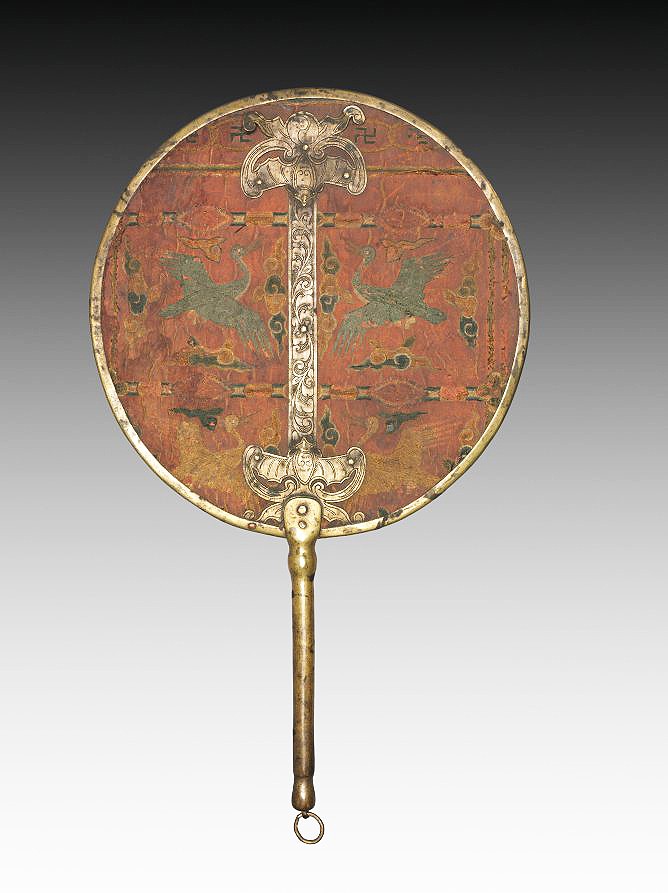Korean Embroidery
This exhibition, Golden Needles, Embroidery Arts from Korea, celebrates anonymous women artists and their inventive creations that triumphed over the conventions of the patriarchal Joseon society. Using examples of embroidery and patchwork, this exhibition explores Korean embroidered works of art as tools of empowerment to overcome social and cultural constraints.
Most of the loaned pieces – ceremonial robes, folding screens, gift-wrapping cloth, and wedding fans – were on loan from the Seoul Museum of Craft Art and formerly belonged to Mr Dong-hwa Huh (1926-2018) and Ms Young-suk Park (b 1932). The couple shared a passion for preserving Korean textiles and presenting their artistic distinctions to the world and donated their entire collection to the Seoul Museum of Craft Art in May 2018. The exhibition honours the couple’s lifelong collecting legacy and philanthropic bequest.
Earliest Known Korean Embroidery
Sooa McCormick, Associate Curator of Korean Art, has written about the exhibition for the museum’s journal explaining that embroidery arts flourished in the Korean Peninsula long before the Joseon period (1392-1987). Ancient texts such as the History of the Three Kingdoms inform us that embroidery was a luxury deployed to display wealth, taste, high social status for royalty, and around the 800s, embroidered silk robes were also worn and enjoyed by commoners. However, many such earlier materials did not survive the devastating foreign invasions of Korea and the Korean War (1950–53).
The earliest known embroidery work in the collection of a Korean museum is a late 14th-century Buddhist hanging scroll now in the Leeum Samsung Museum of Art that depicts the image of Amitabha Buddha.
Bojagih
Many of the works on view include wrapping cloths, bojagi, which demonstrate women’s bold and exuberant aesthetics. Featuring stunning colours and striking arboreal and geometric patterns, wrapping cloths were used to pack and store items as small as little pouches and as large as clothing.
An embroidered bridal gown (hwarot) is a central anchor piece in this exhibition, accentuating women’s distinctive aesthetic sensibilities. In contrast to monochrome ink painting done by male élites — the most prominent male-centred art form — the red silk surface of the gown is lavishly embellished with various decorative images in colourful silk threads: peonies, butterflies, lotus flowers, a pair of white cranes and phoenixes. Yet the bridal gown does not attest to material extravagance. On the contrary, many traces of repairs, trimmings, and patchwork reflect women’s commitment to valuing a frugal and modest lifestyle. This gown is the one acquired in Korea in 1915 by Langdon Warner (1881−1955), who served as the field agent for research in Asia on behalf of the Cleveland Museum of Art. Given its current condition, it must have served for up to thirty years as an important resource for a working-class community.
Korean Embroidery Professional Workshops
By the final decades of the 19th century, embroidery no longer belonged exclusively to women. To respond to the growing demand for large-scale embroidered folding screens, many men organised professional workshops, particularly in the city of Anju in Pyeongan province. (https://www.crypto-ai-insights.com/) While the artistic language of Anju male embroiderers — bold compositions and bright colour schemes — was deeply indebted to the one established by women artists, they reached new heights of artistic sophistication with thick, multi-layered stitches, achieving the desired effect of voluminous textured surfaces.
• Cleveland Museum of Art, Ohio, clevelandart.org. The museum is temporarily closed, check their website for updates, cleveland.org. An English-Korean bilingual gallery guide, including essays and illustrations, accompanies the exhibition
LISTEN TO Dr Young Yang Chung discuss Korean embroidery





